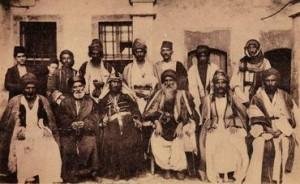Demographics of Yezidi

Historically, the Yazidis lived primarily in communities in locales that are in present-day Iraq, Syria, and Turkey, and also had significant numbers in Armenia and Georgia. However, events since the 20th century have resulted in considerable demographic shift in these areas as well as mass emigration. As a result, population estimates are unclear in many regions, and estimates of the size of the total population vary.
The bulk of the Yazidi population lives in Iraq, where they make up an important Iraqi minority community. Estimates of the size of these communities vary significantly, between 70,000 and 500,000. They are particularly concentrated in northern Iraq in the Nineveh Province. The two biggest communities are in Shekhan, northeast of Mosul, and in Sinjar, at the Syrian border 80 kilometres (50 mi) west of Mosul. In Shekhan is the shrine of Sheikh Adi ibn Musafir at Lalish. During the 20th century, the Shekhan community struggled for dominance with the more conservative Sinjar community. The demographic profile has probably changed considerably since the beginning of theIraq War in 2003 and the fall of Saddam Hussein’s regime.
Yazidis in Syria live primarily in two communities, one in the Al-Jazira area and the other in the Kurd-Dagh. Population numbers for the Syrian Yazidi community are unclear. In 1963, the community was estimated at about 10,000, according to the national census, but numbers for 1987 were unavailable. There may be between about 12,000 and 15,000 Yazidis in Syria today, though more than half of the community may have emigrated from Syria since the 1980s. Estimates are further complicated by the arrival of as many as 50,000 Yazidi refugees from Iraq during the Iraq War.

The Turkish Yazidi community declined precipitously during the 20th century. By 1982 it had decreased to about 30,000, and in 2009 there were fewer than 500. Most Turkish Yazidis have emigrated to Europe, particularly Germany; those who remain reside primarily in their former heartland of Tur Abdin. Population estimates for the communities in Georgia and Armenia vary, but they too have declined severely. In Georgia the community fell from around 30,000 people to fewer than 5,000 during the 1990s. The numbers in Armenia may have been somewhat more stable; there may be around 40,000 Yazidis still in Armenia. Most Georgian and Armenian Yazidis have relocated to Russia, which recorded a population of 31,273 Yazidis in the 2002 census.
This mass emigration has resulted in the establishment of large diaspora communities abroad. The most significant of these is inGermany, which now has a Yazidi community of over 40,000. Most are from Turkey and, more recently, Iraq and live in the western states of North Rhine-Westphalia and Lower Saxony. Since 2008 Sweden has seen sizable growth in its Yazidi emigrant community, which had grown to around 4,000 by 2010, and a smaller community exists in the Netherlands. Other diaspora groups live inBelgium, Denmark, France, Switzerland, the United Kingdom, the United States, Canada, and Australia; these have a total population of probably less than 5,000.
In August 2007, some 500 Yazidis were killed in a coordinated series of bombings in Qahtaniya that became the deadliest suicide attack since the Iraq War began. In August 2009, at least 20 people were killed and 30 wounded in a double suicide bombing in northern Iraq, an Iraqi Interior Ministry official said. Two suicide bombers with explosive vests carried out the attack at a cafe in Sinjar, a town west of Mosul. In Sinjar, many townspeople are members of the Yazidi minority.
The Salafist militant group Islamic State, which considers the Yazidis devil-worshippers, captured Sinjar in August 2014 following the withdrawal of Peshmerga troops, forcing up to 50,000 Yazidis to flee into the nearby mountainous region. Threatened with death at the hands of militants, they faced starvation in the mountains, and their plight received international media coverage, leading American President Obama to authorize humanitarian air drops of food and water onto Sinjar Mountain and US airstrikes against militants in support of the beleaguered religious minority. American humanitarian assistance began on 7 August 2014, with the United Kingdom’s Royal Air Force subsequently contributing to the relief effort. At an emergency meeting in London, Australian prime minister Tony Abbott also pledged humanitarian support, while European nations resolved to join the US in helping to arm Peshmerga fighters aiding the Yazidis with more advanced weaponry. Although Kurdish troops managed to rescue several thousand Yazidi refugees via a humanitarian corridor, helping them cross the Tigris into Syria, one relief worker in the evacuation operation described the conditions on Mount Sinjar as “a genocide”, having witnessed hundreds of corpses.